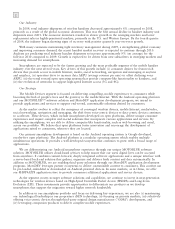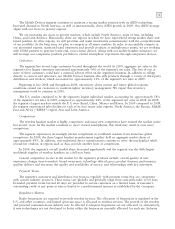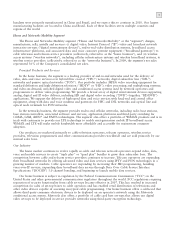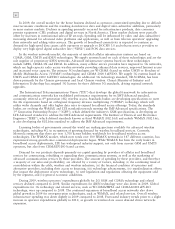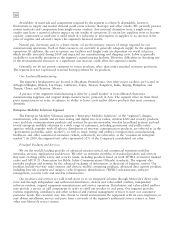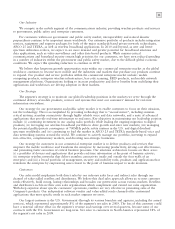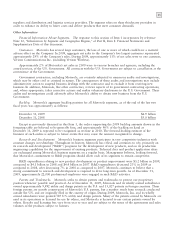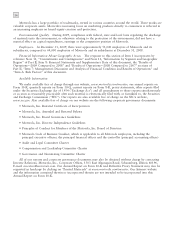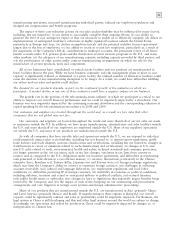Motorola 2009 Annual Report Download - page 20
Download and view the complete annual report
Please find page 20 of the 2009 Motorola annual report below. You can navigate through the pages in the report by either clicking on the pages listed below, or by using the keyword search tool below to find specific information within the annual report.
12
A majority of our sales are made directly by our in-house sales force, and the remainder of our sales are
made through global resellers and distributors. While many industries we serve have shown little to no growth, or
may have even contracted, during 2009, there remains a large number of businesses and consumers globally who
have yet to experience the benefits of converged wireless communications, mobility and the Internet. As the
worldwide economies, financial markets and business conditions improve, the Company will have new
opportunities to extend our brand, to market our products and services and to pursue profitable growth.
Competition
The markets in which we operate are highly competitive. Continued evolution in our industry and
technological migration is opening up the market to increased competition. Key competitive factors include:
technology offered; price; availability of vendor financing; product and system performance; product features,
quality, availability and warranty; the quality and availability of service; company reputation; relationship with
key customers; and time-to-market. We believe we are uniquely positioned in the industry due to our strong
customer relationships, our technological leadership and capabilities and our comprehensive range of offerings.
We experience widespread competition from a growing number of new and existing competitors, including:
large system integrators, manufacturers of mobile computing devices and manufacturers of products in bar code
reading equipment and wireless networks. The segment provides communications and information systems
compliant with both APCO 25 and TETRA industry digital standards. Major competitors include: Harris, EADS,
Kenwood, EF Johnson, Intermec, Honeywell and Cisco.
Large system integrators are seeking to move further into the federal government market. The Company and
competitors in this segment may also serve as subcontractors to large system integrators and are selected based on
a number of competitive factors and customer requirements. Where favorable to the Company, we may partner
with large system integrators to make available our portfolio of advanced mission-critical services, applications
and devices.
Several other competitive factors may have an impact on our segment, including: the consolidation among
telecommunications equipment providers; evolving developments in the 700 MHz band; increasing encroachment
by broadband and IP solution providers; and new low-tier entrants. Numerous companies, including present
manufacturers of scanners, lasers, optical instruments, microprocessors, wireless networks, notebook computers,
handheld devices and telephonic and other communication devices may have the technical potential to compete
with our business. As demand for fully-integrated voice, data, and broadband systems continues, the segment may
face additional competition from public telecommunications carriers.
Payment Terms
Payment terms vary worldwide, depending on the arrangement. Generally, contract payment terms range
from 30 to 45 days from the invoice date within North America and are typically limited to 90 days in regions
outside of North America. A portion of the contracts within our government and public safety market include
implementation milestones, such as delivery, installation and system acceptance, which generally take 30 to
180 days to complete. Invoicing the customer is dependent on completion of the milestone.
We generally do not grant extended payment terms. As required for competitive reasons, we may provide
long-term financing in connection with equipment purchases. Financing may cover all or a portion of the
purchase price.
Regulatory Matters
The use of wireless voice, data and video communications systems requires radio spectrum, which is
regulated by governmental agencies throughout the world. In the U.S., the FCC and the National
Telecommunications and Information Administration (‘‘NTIA’’) regulate spectrum use by non-federal entities and
federal entities, respectively. Similarly, countries around the world have one or more regulatory bodies that define
and implement the rules for use of the radio spectrum, pursuant to their respective national laws and
international coordination under the International Telecommunications Union (‘‘ITU’’). Consequently, the business
and results of this segment could be affected by the rules and regulations adopted by the FCC, NTIA or
regulatory agencies in other countries from time to time. The availability of additional radio spectrum may
provide new business opportunities. Regulatory changes in current spectrum bands may also provide
opportunities or may require modifications to some of our products so they can continue to be manufactured and
marketed.


